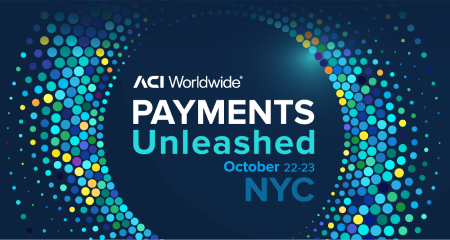- Solutions
- Banking
-
- ACI ConneticUnified cloud payments platform
- AcquiringDigital acceptance, merchant management
- IssuingDigital payments and accounts issuing
- Fraud managementReal-time enterprise fraud management
- RTGS / Wires and cross-borderMulti-bank, multi-currency processing
- Real-time, instant paymentsComplete real-time payments processing
- ATMsSelf-service, omnichannel digital experience
- Central infrastructureInnovative real-time payment infrastructure
- NEW Redefining the payments hub: Solving today’s banking payment challenges
-
- Merchant payments
- ACI Payments Orchestration PlatformEnable customer journeys across commerce channels, accept payments, prevent fraud and optimize your payments journey
- In-storeDynamic, modern in-store payments
- eCommerceOnline and mobile payments
- Alternative payment methodsGive more ways to pay
- Value-added servicesEngagement, optimization and reporting
- Fraud managementEnd-to-end fraud orchestration
- Risk, security, and complianceAchieve and maintain compliance
- NEW Datos names ACI Worldwide best-in-class in payments orchestration
- Industries we serve
- Billing and bill payments
- ACI SpeedpayDrive customer satisfaction with the widest range of bill pay options in the industry.
- Bill payment APIs and SDKsOutsource bill payment processing
- Fraud managementAI-based fraud orchestration technology
- Alternative payment methodsGive more ways to pay
- Loan servicingPreferred loan payment options
- Treasury managementStreamline and integrate your back office
- Automated debt collectionImprove your collections process
- Digital walletsManage digital cards and payments
- PCI compliance and securityAchieve and maintain PCI compliance
- Industries We Serve
- Fraud management and payments intelligence
- Fraud managementFraud solutions to minimize risk and prevent fraud
- Fraud management for bankingEnterprise-wide fraud prevention
- Anti-money launderingStay ahead of money-laundering schemes
- Robotic process automationAutomate payment processing operations
- Fraud management in the cloudProtecting your business in the cloud
- Fraud management for merchantsProtect payments from end to end
- ChargebacksPrevent chargebacks before they happen
- SCA complianceAchieve and maintain SCA compliance
- Digital identity solutionsConfirm identities with behavioral analytics
- NEW Scamscope fraud report: APP scam trends from around the globe
- Company
- Customers
- Partners
On this page
Payments orchestration optimizes multiple payment processing providers and methods using a single, unified platform. Think of it as the conductor of an orchestra, ensuring each instrument plays its part harmoniously. This approach not only simplifies payment processing but also enhances overall efficiency and effectiveness.
Key benefits for merchants and payment service providers (PSPs)
- Flexibility and scalability: Integrate various payment methods and gateways without being tied to a single provider
- Cost reduction: Significantly reduce processing fees by optimizing routing and leveraging competitive rates
- Enhanced security: Ensure a secure payments ecosystem using advanced fraud prevention measures and real-time analytics
- Resiliency: Automatically re-route transactions to an alternative PSP if another PSP is down
How does payments orchestration simplify the payments process?
According to S&P Global Market Intelligence, merchants surveyed stated that their payment systems are complex. The findings table below indicates that even the outliers who reported “not so complex” systems acknowledge they are increasing in complexity. Complexity was shown to correlate with the size and age of the merchant.
Complexity level and expected changes in complexity over the next 24 months
| Complexity | Significantly decreasing complexity | Somewhat decreasing complexity | No change in complexity | Somewhat increasing complexity | Significantly increasing complexity |
| Extremely complex | 11% | 12% | |||
| Very complex | 11% | 22% | |||
| Relatively complex | 33% | ||||
| Not so complex | 11% |
451 Research’s “Voice of the Enterprise” report reveals that 63% of merchants strongly agree that their businesses need to reduce the time developers spend on payment functions. Only 8% said they disagree. Industry-leading payments orchestration solutions manage the integration and administration of payment types, including alternative payments, so developers do not have to code new payment types or continuously manage updates to them.
Payments orchestration streamlines processes and integrates separate systems, providing merchants with a comprehensive view of their payments. This enables more informed and strategic decision-making.
Real-world payments orchestration success stories
A significant number of merchants and payment service providers (PSPs) are realizing the advantages of payments orchestration. For instance, a leading eCommerce retailer reported a 20% increase in revenue after implementing a payments orchestration platform that optimized transaction routing and reduced processing fees. Similarly, a global PSP achieved a 15% reduction in fraud-related losses by leveraging advanced analytics and real-time monitoring.1
Fraud and payments: A symbiotic relationship
It’s not just about accepting payments and mitigating fraud—it’s about how payments and fraud work together to achieve better results in your payments orchestration. By integrating fraud prevention measures with payment processing, businesses can create a seamless and secure transaction environment. This collaboration ensures that fraud management, and the wealth of intelligence it brings, is not just an afterthought but rather an integral part of the payments process.
Effective fraud management requires a coordinated approach. No single solution can make precise decisions independently, so trusted sources across the ecosystem must be utilized. AI-powered fraud orchestration enables merchants to make rapid decisions on transactions—whether to accept, deny, or challenge them. This approach aims to minimize fraud and improve conversion rates by preventing the rejection of legitimate transactions.
See how incremental learning is a gamechanger for payments fraud in this related article
The role of fraud and analytics
Fraud prevention and analytics play a crucial role in payments orchestration. Real-time monitoring and data analysis are necessary to take immediate action. This proactive approach not only protects against fraud but also provides valuable insights into consumer behavior and transaction patterns.
By analyzing transaction data and customer behavior, businesses can identify patterns of fraud, such as frequent returns.
| Key indicators |
| Device and account type |
| Bank or merchant |
| Utilities |
| Fingerprints |
| Emails |
| User behaviors or location |
| Authentication methods |
| Cards, transaction type/amount, and alternative payment methods |
| Frequency |
| Address |
But what role does tokenization play in this process?
Tokenization: The unsung hero
Payment tokens substitute the card number with a unique identifier that can only be accessed within a token service provider’s secure token vault. These tokens are specifically linked to a device or merchant, ensuring that only the respective device or merchant can use them, thereby preventing fraudsters from exploiting them. Additionally, network tokens are issued by acquirers and major card networks.
One of the primary advantages of using tokens is their uniqueness and ability to securely share with internal and external systems. This facilitates the integration of previously siloed systems within the payments orchestration system, thereby reducing latency. This reduction in latency can be important for Buy Online Pick-Up In-Store (BOPIS), Buy Online Return In-Store (BORIS), and loyalty programs.
For instance, consider a situation involving a fraudulent individual who cancels an in-store pick-up transaction via their mobile device while an employee retrieves the item from the back. Any system latency in this scenario would allow the fraudster to leave the store undetected, resulting in the cardholder being unaware that their card had been stolen and the merchant incurring the loss.
Importance of a tokenization strategy for merchants and PSPs
In recent years, tokenization has seen significant growth. According to Digital Transactions, as of February 2025, Visa’s token volume increased by 40% year over year, reaching 12.6 billion tokens. Mastercard processes approximately 1 billion network tokens per week. Networks are supporting this strategy by offering discount points on transactions utilizing tokens. Furthermore, network tokens streamline the payments process, reduce transaction fees, and improve authorization rates. According to Mastercard, on average, merchants can save up to 20% on transaction fees and reduce fraud-related losses by 15% by using network tokens.
Merchants receive network tokens, device tokens (such as those from Apple Pay, Google Pay, Samsung Pay), and in many instances, acquirer tokens. How do they manage these tokens effectively?
The power of one omni-token
One omni-token can link everything together by providing a unified tokenization strategy that integrates with various networks, acquirers, and PSPs. This approach ensures that merchants have full control over their tokenization process, allowing them to leverage the benefits of network tokens while maintaining interoperability and security. By using a single omni-token, businesses can simplify their payment processes, reduce costs, and enhance the overall consumer experience.
To learn more about the different types of tokens a merchant is receiving and how merchants retain control and flexibility, read the blog, “One token to bind them all”
How to implement a payments orchestration platform
Transitioning to a payments orchestration model may seem overwhelming, but it’s a necessary evolution for growth-oriented retailers. Here’s how to get started:
- Evaluate current systems: Create a comprehensive review of your current payment processes, including conversion rates and costs. Identify existing vendors and assess their ability to offer holistic services
- Choose the right partner: Select a payments orchestration platform provider that aligns with your industry needs, customer expectations, and budget. Look for POPs that offer robust security features, flexible integration options, and a wide range of payment methods
- Prioritize security and compliance: Ensure your chosen platform complies with industry standards and offers strong authentication and fraud prevention features
- Embrace flexibility: Use the flexibility of payments orchestration to experiment with new payment options and refine your approach based on customer feedback and transaction data
As consumer expectations continue to rise, the need for a robust and flexible payments system becomes critical. POPs enable retailers to meet and surpass demands, leading to greater innovation and customer satisfaction. By embracing this transformative technology, businesses can enhance their checkout experience, optimize their operations, and ultimately drive growth in an increasingly competitive market.
Conclusion
Payments orchestration is not just a buzzword—it’s a transformative approach that offers immense benefits to merchants and PSPs. From enhanced security and cost reduction to improved consumer experiences, the advantages are clear. By embracing tokenization and leveraging advanced analytics, businesses can stay ahead in the ever-evolving payments landscape.
Centralizing the entire payments and fraud ecosystem is simpler than you think. Download the “Moving from payments coordination to payments orchestration” whitepaper today to get expert insights into transitioning over to a single, secure, easy-to-integrate platform that is built for you.
About the authors

Darren Wood
Senior Payment Solutions Consultant
With nearly two decades of experience in the payments industry, Darren is dedicated to partnering with organizations to comprehend their challenges, helping them understand changing consumer behaviors and the need for real-time payments adoption. These are essential for supporting European banks, intermediaries, and merchants in competitive markets.
- ACI internal data ↩︎



